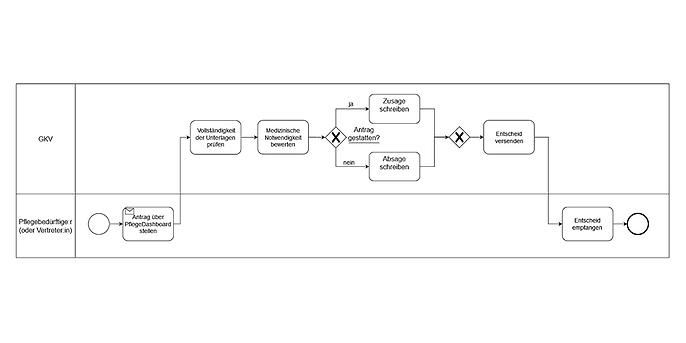7. February 2024 By Jakob Michaud
BPM & Process Mining in the healthcare sector - Operational excellence through process mining in statutory health insurance companies
What is process management and what is process mining?
In the ever faster changing world of health insurance companies, process management is not just a buzzword, but a crucial tool for reacting promptly to new requirements of the SGB or enabling digitalisation projects. Fundamental measures are the documentation, analysis, optimisation and control of existing business processes and their support by application software. This makes process management an integral part of the implementation and continuous monitoring of the business strategy.
In addition to "classic" process management and its manual recording of workflows through interviews with technical experts, process mining, a data-driven approach, has become increasingly important in recent years. Process mining uses the information generated by workflow systems, such as activity names and time stamps, to reconstruct the actual workflows based on these traces. This technology enables a precise analysis of the process landscape, revealing the digitalisation potential for transformations. In contrast to business intelligence, each process step becomes visible and reveals the causes of long throughput times instead of mapping them via an abstract KPI.
In the area of SHI, in addition to the potential for digitalisation, transparency is also created via dark processing for specially designed process sequences. This enables the traceability of automation in quantitative and qualitative terms.
Process mining always involves processing technical and non-employee-related data. The aim is to analyse all business transactions and not the performance of employees. Involving employees in the process mining project at an early stage gives them security and supports them in their day-to-day work.
Where does process mining make sense in SHI?
A growing number of health insurance companies are already successfully analysing and automating benefit applications, cost reimbursements and bonus programmes using process mining. In principle, all processes that have a certain number of process instances or cases are worth analysing.
For processes with low case numbers, analysing them using process mining can still be useful in order to increase policyholder satisfaction. Particularly in areas such as income applications, an automated status tracker provides a clear overview to closely monitor the ongoing process internally. This not only leads to efficient administration, but also increases customer satisfaction by providing insight into the status of applications. Complex, manually modelled process maps are transformed into well-coordinated process flows through process mining.
Case study of additional services
It also makes sense to take a closer look at recurring mass processes, such as those that occur when applying for supplementary benefits in accordance with Section 45b SGB. The integration and monitoring of these processes in IT systems offers considerable advantages. Every day, numerous applications for subsidies for home care aids or home adaptations are received that need to be processed. Analysing these processes using process mining uncovers bottlenecks and enables shorter processing times, among other things.
Modelled process

Lived process

What are the advantages of process mining?
- Structured standardisation: The standardisation of processes makes workflows more transparent, which enables cross-workplace and cross-departmental evaluations. Traceability enables health insurance companies to recognise errors in a targeted manner. In addition, the standardised and graphic documentation of processes supports reproducibility.
- Improved collaboration: The clear presentation of responsibilities improves collaboration both within teams and between departments. This increases the quality of teamwork, promotes productivity and provides a clear overview.
- Secure compliance with legal regulations: By controlling processes, compliance with legal regulations is checked and facilitated. Targeted compliance with internal guidelines is also supported, which significantly reduces potential risks.
- Identification of automation and digitalisation potential: Recording process flows enables the identification of high loads and bottlenecks in the company. This analysis shows where significant added value can be created through digitalisation and which technologies make sense for this.
How can adesso help with the introduction and further development?
We are an interdisciplinary IT consulting company and combine:
- Many years of experience in statutory health insurance,
- Expertise from other areas of the healthcare sector,
- technical knowledge of data structures and interfaces,
- Methodological knowledge from process management and
- Change management and agile coaching.
Our range of services in process mining includes
- 1. setting up the project: kick-off with relevant stakeholders to define the project objectives and the associated rough requirements.
- 2. implementation:
- a. Evaluation and implementation of process mining tools (optional)
- b. Connection of the source systems: We support health insurance companies in the implementation of process mining tools and the connection to existing systems (such as Kern21c).
- c. Process identification: Development of initial dashboards for the visualisation and explorative analysis of process flows in real time. In this phase, adesso creates an MVP that can later be expanded into a full version.
- d. Process analysis: Together with the specialist departments, we develop relevant use cases, for example the definition and presentation of important KPIs.
- e. Process optimisation: We develop strategies to optimise processes in order to improve policyholder results, reduce costs and increase operational efficiency. This also includes the automation of processes where this makes sense.
- 3. training: We offer coaching for employees to ensure that they use the tools and processes effectively.
- 4. competence centre: We ensure that process mining is anchored organisationally as a tool and work with our customers to establish a central point of contact. This instance is the point of contact for queries and is responsible for company-wide scaling in the self-learning organisation.
Conclusion
The introduction of process mining in SHI accelerates the adaptability of health insurance companies at the business process level. The process for applying for care services in accordance with §45b SGB is used to show how process mining identifies the actual process and thus makes it assessable.
Our consultants at adesso support you in the introduction and expansion of process mining - feel free to contact us!
You can find more exciting topics from the world of adesso in our previous blog posts.
Find out more on our website about why digitalisation offers enormous opportunities for cost bearers.

